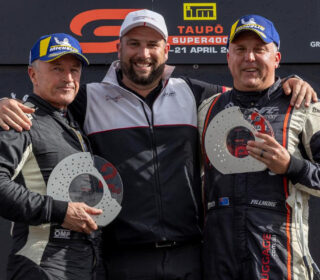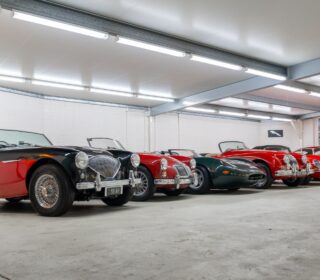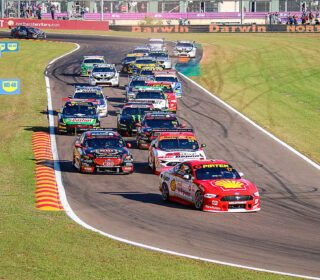Porsche: Road vs Race
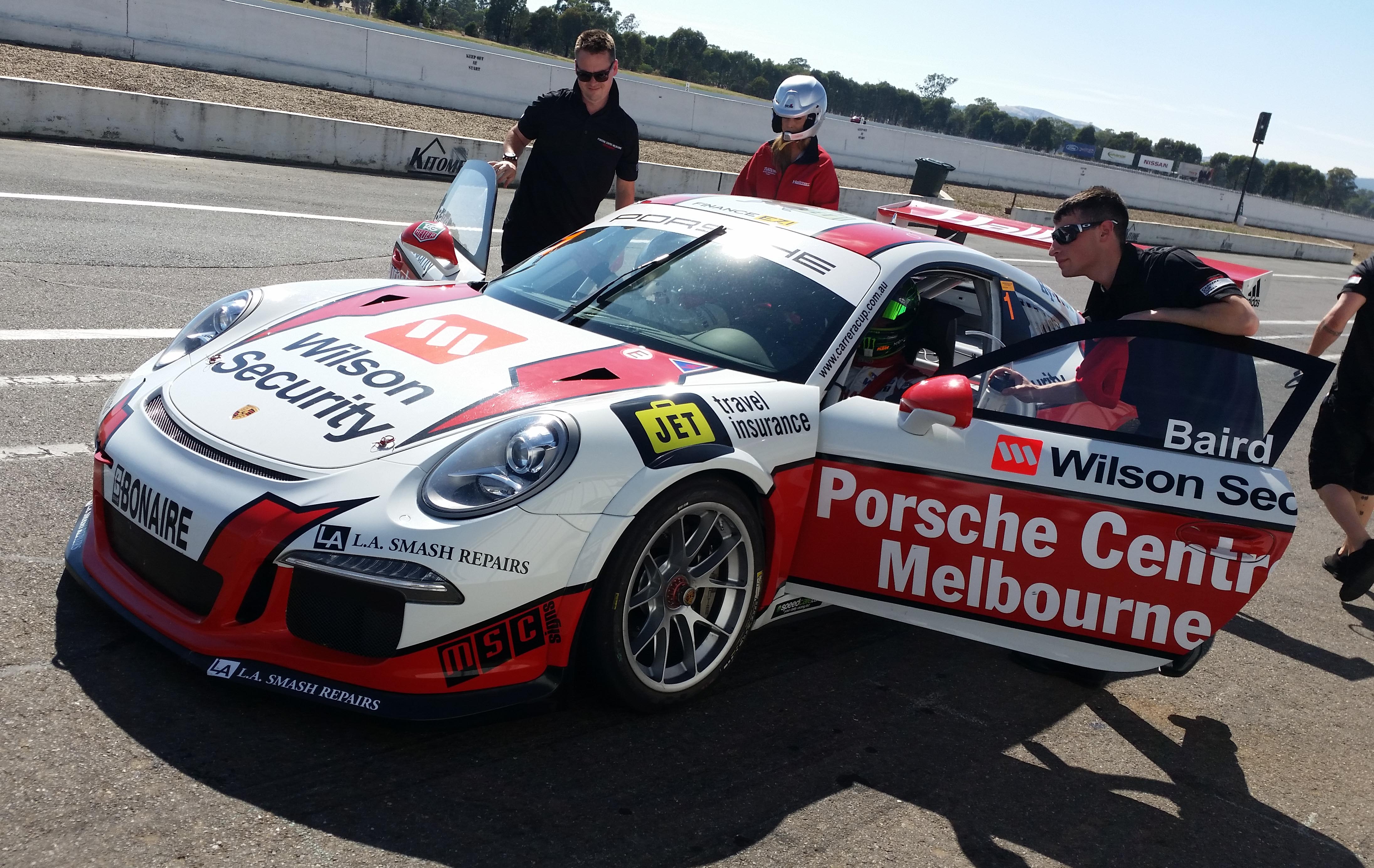
THE LONG and mind-numbing drive down the Hume highway allows time for contemplation while dodging road trains, roadworks and the all-to-familiar white and grey protrusions for speed monitoring that dot its bottom end, closer to Melbourne.
With cruise control set to a GPS-verified 110km/hr – I can’t afford speeding fines – the humdrum rental car churns out the miles while I get the chance to contemplate the morning I’ve just had at Winton Raceway, near Benalla.
It is a rare occasion you get to compare cars on a race track. It’s rarer to do it with a high-end brand like Porsche. And it’s rarer again to do it with two of the best drivers around to guide your experience.
And yet, that’s where I find myself on a bright, warm Tuesday morning in December. On offer? A type 991 Porsche Turbo S and its race going brother – the 991 GT3 Cup Car from Australia’s Porsche Carrera Cup.
This is not, of course, a fair comparison. You can’t just throw a car designed for the road on a track and expect it to compete with a purpose-built racing machine, but it does offer an interesting opportunity to see how Porsche’s fastest ‘everyday’ road car competes with the racing brethren it’s so famous for.
And so, with Winton at our disposal, the sun shining from a brilliant blue sky and the drivers taking some early hot lap victims out early to warm up body and cars alike, we throw on a helmet and walk towards the stunning blue supercar with evocative script sprawled across it’s wide, inviting rump.
T U R B O.
This should be fun.
**
EVEN THOUGH it is wider, longer and fatter than its 997 predecessor, the immediate impact of the 991 is how physically small it actually seems.
Each curve and crease seems to shrink the low and wide proportions of the classic-yet-fresh ‘new’ 911 shape. In the brilliant metallic blue this car is presented in, it looks stunning – without the overt flair of the road-going GT3 but with enough menace and purpose to give hint to the inherent intent.
In the passenger door – bob the head to avoid whacking helmet on roof – and slide low into the comfortable, supporting leather seat and receive a warm ‘G’Day’ from our driver, Karl. That’d be Karl Reindler, thanks – former V8 Supercar full-timer and A1GP racer of note. Very, very capable hands, then.
First impressions of the Turbo interior is that this is no stripped-out racer. It’s comfortable: all leather, alcantara and brushed aluminium and a surprisingly spacious place to be. It’s cool, too – it’s now nudging 30 outside in Victoria’s North so the respite thanks to the Porsche’s powerful aircon is welcomed.
“I fell asleep where you are sitting when we were driving up here this morning,” Reindler says, his quip either a ringing endorsement of the Turbo’s cruising ability or his lack of sleep thanks to then three-week-old daughter, Charlotte. I suspect both.
The car is already running but its 3.8-litre flat six is nearly silent at idle. We move away from the pit apron smoothly, seven-speed PDK semi-auto clicked into first by the lovely alloy paddle behind the similarly well-designed wheel, Porsche shield front and centre.
And then, we get to the de-restricted sign and do the Star Trek-style quantum shift into hyperspace. Oh, my.
The Turbo’s 3.8 – all new for the 991 – does not shout or bellow its intention. Instead, it makes a noise you might hear in a sci-fi film as a space ship flies overhead: it’s a low, sweet baritone and pleasing but doesn’t trouble the neck hairs nor the ears for volume, thanks to the turbos.
But what it lacks in aural drama it makes up for in the sustained violence in the way it projects the car forward to the horizon.
There is no turbo lag, no delay, nothing to prepare you for the rate of knots at which this thing gathers speed in a straight line. With a scarcely believable 556bhp at six-five – this is no low-revving turbo, thank you – it feels powerful but the torque is undoubtedly the key factor here. All 750 (yes, you read that correctly) of newton’s meters (when the overboost function is activated) come low in the rev-range, only enhancing the thrust as this little blue rocket thunders towards the horizon. At every part of the rev range and in every gear, the acceleration is sustained, comprehensive and truly remarkable. It’s bonkers, and because it’s four wheel drive and has sticky Michelin Sport Cup tyres on each corner, there’s plenty of traction too.
And then, we get to the de-restricted sign and do the Star Trek-style quantum shift into hyperspace. Oh, my.
And so within a very short space of time we get to the first corner and Reindler (not having a bad day of work, it must be said), tips the 1650-kg Porsche in at significant speed. The first reaction is that this car has a mighty front end, a fact that the driver backs up moments later.
“It’s very quick steering, and if you’re not careful it unsettles the rear end on entry. The steering is just ridiculous,” he says, pausing to catch a half-turn of opposite lock midway through Winton’s turn five, a long, loaded 150kph left hander.
“But it’s got so much grip,” he picks up again as we tackle the series of three right-left-right hairpins affectionately known as Winton’s ‘cleavage’. He’s on the throttle insanely early, all four wheels offering remarkable traction as the adaptive dampers measure the ride and balance of the thing. It corners spectacularly: I’m hanging on for the amount of lateral G’s its pulling.
“I just tried to unsettle the rear there and it just won’t.. it just sticks and goes. It’s every bit as fast as the other (Cup Car) in a straight line, too. It’s a lot of fun.”
But not remote: Our driver is working hard and I feel the car dancing beneath me from the passenger seat, clearly finding the very edge of what the street-legal tyres can offer in terms of grip and traction on the racing surface. Karl is hustling the car to extract time, too, but clearly enjoying himself: from where I sit, it looks like a riot.
Our laps end and Karl returns to the pits, ready for the next victim who will surely be as impressed as I am about the remarkable capabilities that the Turbo offers its drivers – and passengers. From nap on the Hume to 220km/hr at Winton all within the same morning, this blue machine truly seems a usable Supercar.
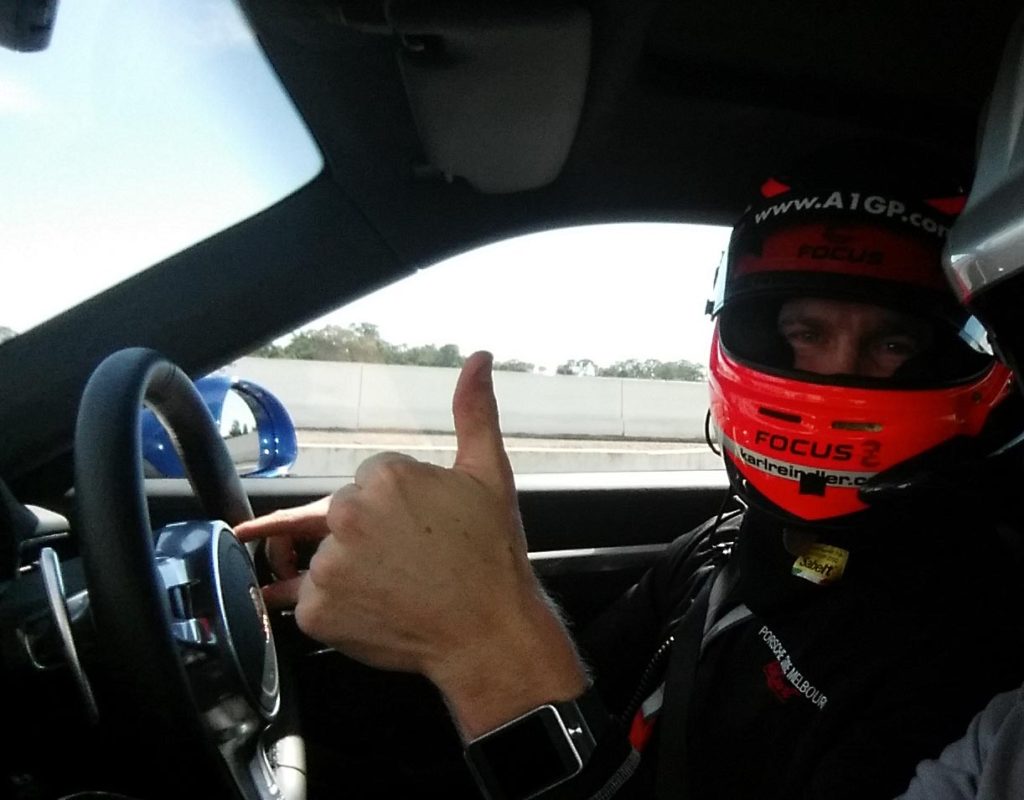
SO NOW WE head out of the kitchen and into the fire – quite literally as it turns out. From the air conditioned cool of the Turbo, Craig Baird’s 2014 Carrera Cup Australia mount is hot, both in temperature and ability.
The current Cup Cars scream intent. Their pumped-out guards accommodating slick Michelin control tyres wider and taller than their predecessors. There’s more aero and because of that, more downforce, and an altogether more purpose-built race look. Sitting alongside an older Gen 2-997 cousin, the 991 looks more modern, more up to date and faster.
Like so many others, I remain in awe of Porches’ ability to design a car that looks exactly the same as the old model yet actually, is fundamentally different and much fresher.
Obviously, it’s more purposeful on the inside, too. Gone is the carpet, leather and alcantara (and the air con, notably.. I’m already sweating) and in its place sits a mass of cabling, ECU boxes and the scaffolding that keeps the drivers safe first, and adds torsional rigidly second. Or, more likely, the other way around if you’re the engineers who designed it.
As a result you sit in the passenger seat crooked, legs splayed to the right to avoid the large boxes of electrical gubbins situated in the passenger footwell.
Six-point belts tight and (admittedly large) posterior wedged into the passenger seat, it’s time to go. I look across to the familiar Monster-sponsored helmet to my left and give the thumbs up.
Ahh yes.. that helmet.
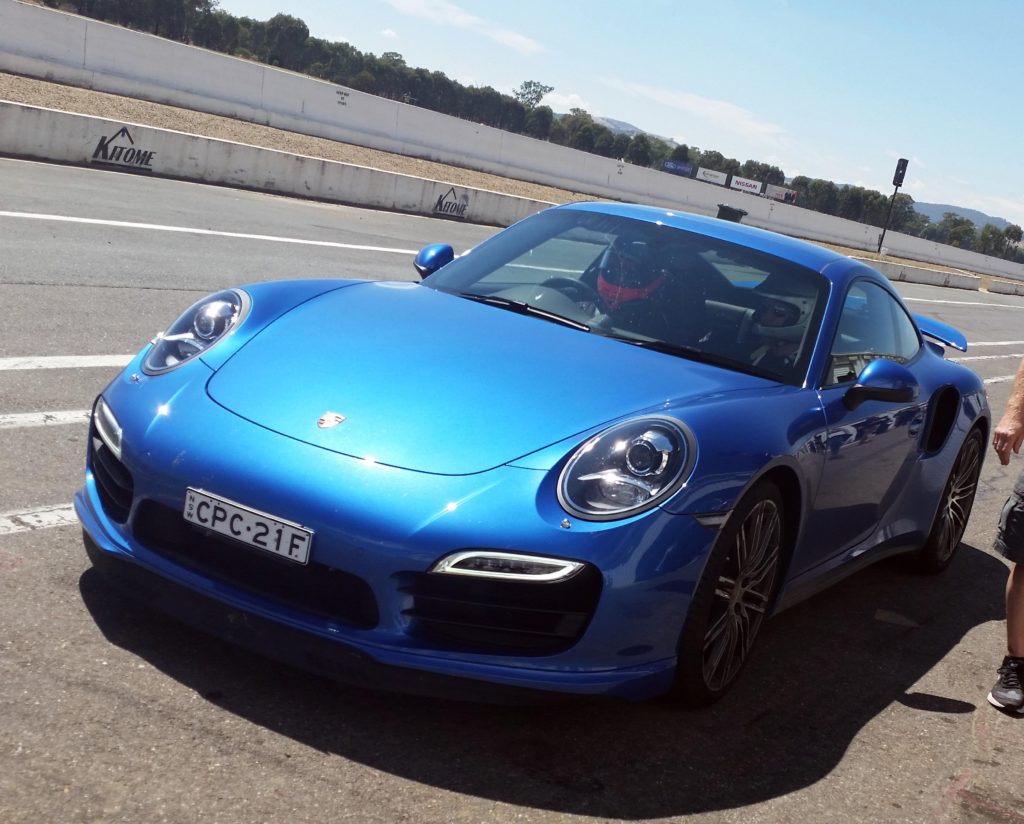
CRAIG BAIRD is our driver today and that’s good. In fact, it would be impossible for it to have anyone better this side of Porsche’s latest signing, one M. Webber.. though you’d in a Cup Car battle you’d probably back Baird against the double Monaco winner. The Kiwi is the most successful one-make Porsche driver in the world and owns almost every record in the Carrera Cup record book – his five championships matched with more than fifty wins and one round victory in every three-point-five round starts. So dominant has he been in Australia that Steve Richards’ breakthrough title win this year made him the first driver not called Craig Baird to win a Porsche Carrera Cup Australia since 2007..
Like the outside and inside of the car, the engine has a harder edge: it’s more metallic, sharper and louder, too. There are no turbos to muffle the exhaust and, to be fair, not that many mufflers to do the job either.
The car starts easily but it’s jittery as we move away, low revs needed as you ease the racing clutch to its bite point and it slowly moves from the bay, juttering and shunting down the lane at the low, 40kph limit.
The Cup Car gathers speed differently to the Turbo, but no-less effectively.
Where the Turbo offers sustained force, the Cup Car progressively gets better and better up the rev-range, pressing you back harder and harder into the seat with every growth of the RPM counter on the digital dash that sits visible for the driver between the top of the wheel and its hub.
So if the Turbo relies on its 750Nm to propel it forward, the Cup Car combines the 450hp 3.8-litre flat six with the much lower 1250kg kerb weight and every single one of the available 9,000 revolutions the engine has to offer to deliver performance. It’s the same, but different.
It’s not overly loud but damn it sounds good in here – it’s another key higher than the Turbo altogether and it’s amplified by the drum-like interior, stripped of anything that absorbs sound. As the revs rise to their stratospheric peak so does the cacophony of sound from the gearbox, becoming higher pitched with each change as the longer ratio is selected.
Like every Cup Car before it and I am sure everyone to come, the only way to tell people what it sounds like is that it’s ‘like a Porsche sounds’, and leave it at that.
The gearbox is special, too. The 991 was the first one-make Porsche racer to feature the paddle shifts and it is a startlingly effective gearbox. I’m not sure if it’s just that the lack of a mechanical linkage makes it seem less physical, or if it is indeed better, but this ‘box immediately seems faster and easier to use than the 997s I’d ridden in earlier.
As the revs rise to their stratospheric peak so does the cacophony of sound from the gearbox, becoming higher pitched with each change as the longer ratio is selected
There is very little discernible pause as each shift is banged through, downshifts met with a pleasing ‘bwarrp’ as the flat six matches revs and wheel speed to avoid rears locking.
At this point, we should talk brakes. The only way you could experience the decelerative forces on offer in a 991 Cup Car would be to crash a large plane going very quickly into an equally large mountain. While the acceleration comes as a rising wave of performance, the braking is in reverse: the initial application hauls you forward, harnesses digging into skin. The effort to hold your neck up physically hurts after a few laps. I imagine pulling a late-braking pass off on a rival into a slow corner from a high terminal velocity would be extremely satisfying.
It’s now that you truly feel the benefit of slick tyres too, and perhaps a bit of downforce to boot. Baird is smooth on entry, early to the throttle and using only small corrective inputs mid-corner. Smooth is fast in these cars and clearly, it’s why Baird has won so much stuff in them.
Laps in the Cup Car tell a lot about why so many people covet them as race cars – and perhaps why they don’t quite have the outright fan appeal of, say, a fully-blooded GT car. They are so completely competent in everything they do – performance, braking, handling, looks, sound, and everything in between. Good for those driving, perhaps not quite so much for fans, but what a staggeringly effective, impressive machine.
Driver goes alright, too.
**
THE TURNOFF to the Tullamarine freeway and Melbourne’s airport looms as the traffic begins to build towards another challenging Peak hour in this rapidly growing, expanding, exciting city. Still, the mind lingers on the experiences early in the day.
I always knew the Cup Car would be sensational: experiences in the previous generation 996s, 997s and other similar cars and the fact that Porsche rarely tends to engineer things backwards was enough proof that the 991 would be epic – and it was.
But perhaps the biggest surprise was how close the Turbo actually felt. If anything, the road car was more startling in a straight line. There’s nothing scientific in my reasoning, but the remarkable instant thrust of the Turbo – coupled with a shorter spread of ratios (seven versus six) made that car the more accelerative of the two. Certainly there was nothing in it in ultimate straight line.
Its corner entry savagery and corner exit grip were impressive, too, and I never got the impression of the extra mass the road car has. In Karl Reindler’s impressive hands it felt lithe and nimble.
THAT Porsche can engineer a road car that so is so incredibly capable in all regards – remember, it was so civil on the road that it sent the race car driver to sleep in the passenger seat – is a mark of how on top of their game Porsche are on at the moment.
That they can produce a racing car so overwhelmingly competent in every regard as well only adds to their credibility.
That the road car gets so close is even more remarkable.
Yes. Quite a good day, then.
This story was first published in December, 2014.



